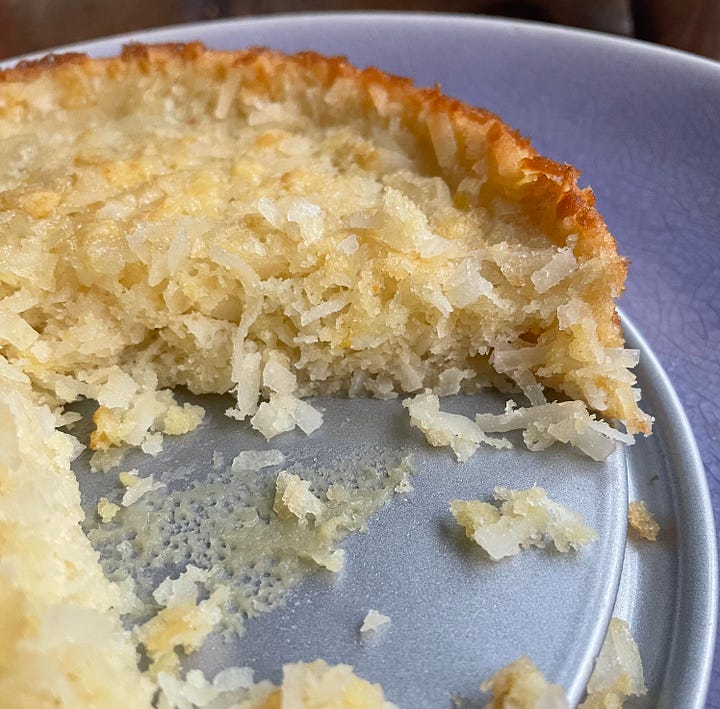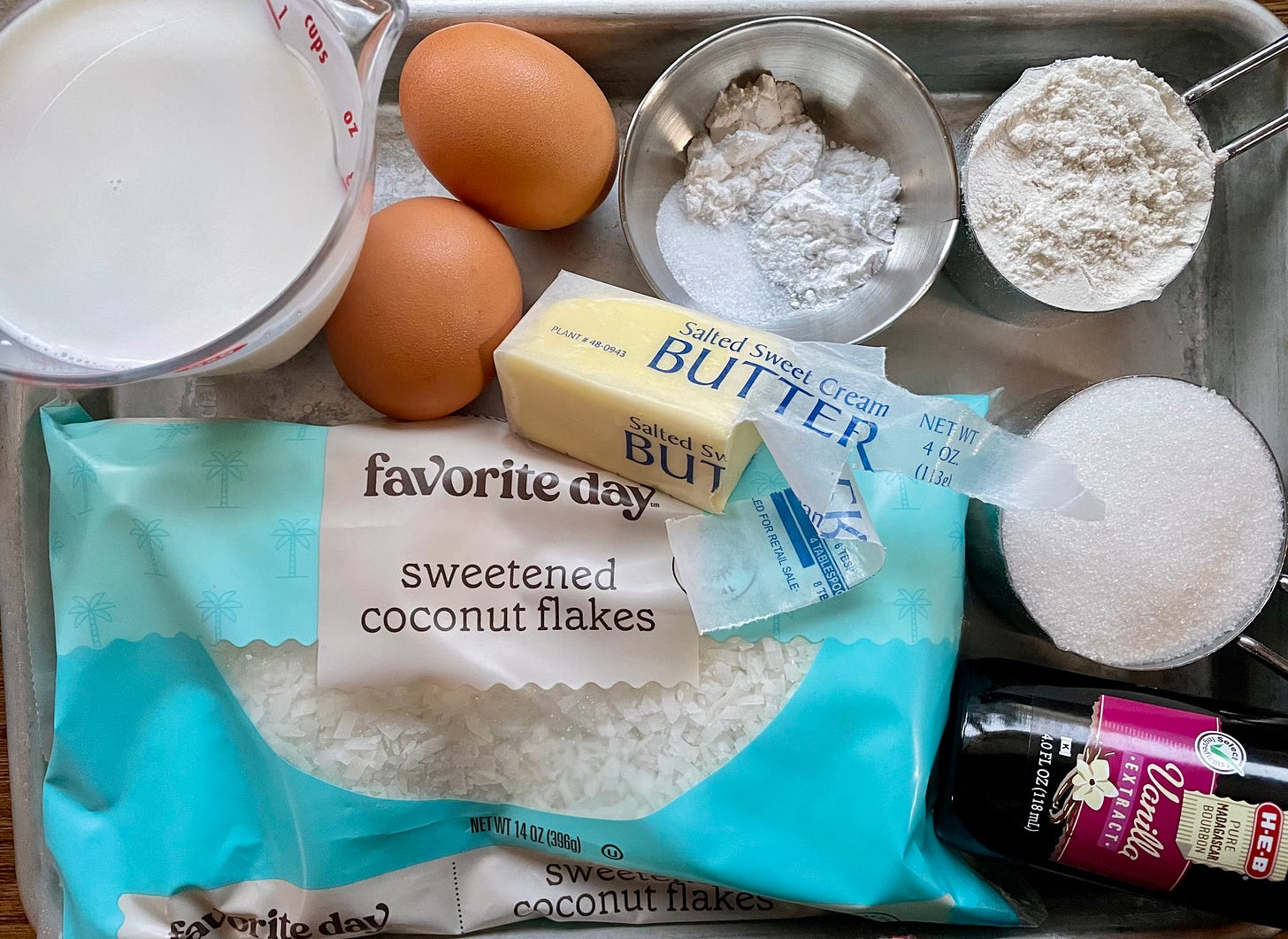Vintage Recipe Roulette: Impossible Pie
Magic one-step layered pie, or scrambled egg Uncrustable? Only the baking time will tell...
In case this is your first time visiting the Department of Antediluvian Disquietude and you missed the first installment, this is the latest in a series of Vintage Recipe Roulette reviews using only recipes from Talk About Good, my grandmother’s 1975 community church cookbook. In just 164 pages, this collection of homestyle recipes encapsulates the unlikely intersections of 1800s frontier cuisine, post-war convenience foods, and the mid-century American fetishization of canned chow mein noodles. It is untested, unstandardized, and unmatched in its vintage glory in my opinion. Some of the recipes are amazingly good! And some are amazingly…not. Today, we make a single-step recipe that separates to form a crust and filling. Theoretically.
Behold, the impossible dream: a pie without making a pie crust.
(I’m leaving the recipe above in the photo because it’s so interesting. I saw my grandmother and a friend’s mom make caramel/dulce de leche/cajeta in the can that way, but it the can can (haha) be extremely dangerous, and there are other ways…should we cover this in a later installment?)
Our chosen recipe today is the second one, though. It sounds unlikely, and the chances of it working out are right there in the name! Let’s see if this recipe precipitates a crust, or a nervous breakdown.
This concept reminds me of self-saucing puddings, where your single-step batter makes a cake-like substance rise to the top with a liquid-y component settling to the bottom. There are actually a lot of similar “impossible” recipes, like Pennsylvania Dutch Funny Cake, or the more difficult but also more dramatic Magic Custard Cake. Some are even savory, like this Betty Crocker “cheeseburger” one that uses Bisquick. If you’ve ever had a cake fail in an extra weird way, it might have been because there was too much liquid, so the solid components had a chance to settle into layers by relative density, sometimes aided by gas bubbles, before the egg set. Impossible pies aim to use that fatal flaw to their advantage.
This one, with coconut, should settle into 3 layers — a crusty bottom, a custard-like middle, and a crackled coconut top, something like a chess pie. Don’t expect a flaky pie crust — it’ll be something more like a dense cake at the bottom. I’m a little concerned about how much egg there is in this…it could lead to gratuitous flan.
I’m not a flan fan.
Like most community recipes, this one is light on instructions. Some of the unspoken assumptions that I think are likely: Using room temperature eggs is often critical in baking, lest the outside scorch while the inside remains stubbornly raw, and in this recipe, that technique might also cut down on any egg-y flavor. (That helps with egg-based keto breads if you enjoy those. You can have mine.) In addition to the egg-heavy ratio, I’m also worried about the instructions to not grease the pan, because that little tidbit instruction has resulted in baked good-to-pan adherence in the neighborhood of landscaper’s glue. But, sometimes a little bit of stick is required for a proper rise without a devastating fall, such as with angel food cake; it gives the batter something to cling to while it develops its own stable structure.
Isn’t that what everyone wants? I’ll follow the instructions. Let’s hope it doesn’t end in tears.
Anyway, the last recipe note is that there’s no baking temperature specified. In old community cookbooks, this often means a “moderate” oven — about 350 degrees — but it might be an oversight. I’m going to set it to 350, cut the baking time a bit because of the smaller pan, and hope for the best.
Here are the rest of the ingredients. I’m just making half the recipe in a small springform pan. It’s quite simple, and you don’t need a boxed Bisquick for any recipe, ever — it’s just flour, leavening, salt, and fat, and mixing your own saves a lot of dough. I often cut the sugar a bit, but I didn’t for this one, because I’ve never made it before and am not sure how much the sugar contributes to the structure.
Once you mix it up, it looks like this — very, very liquid. Nowhere near pancake batter, even.
My pan choice is designed to help me get a slice out more cleanly if it sticks, but springforms are risky with a thin batter, because they might leak. I let it sit for a few minutes while the oven finished heating, and it was so far, so good…but I put it on a baking sheet just in case…
…And that was a good idea, because it did leak just a teeny bit. It looks nice, though! It actually needed the full baking time despite being half the volume, so I wondered whether a hotter cooking temp might have been better, but looking around at similar recipes, they all use 350 for the coconut version, although Bisquick’s savory ones are more like 400. It might be worth trying a hotter temp and shorter bake time to see whether it sets the layers more distinctly.
After it cooled, I ran a slim wooden skewer around the edge, and it came out just fine. This recipe does not slice cleanly because of its very tender crumb with the coconut on top, but chilling before serving would help. Unfortunately, you can’t really see the layers in this photo, but you can feel them when you eat it. There’s a sticky, browned coconut topping, a softer and slightly eggy but less coconutty middle, and then a totally coconut-free, dense spongecake-like bottom layer. I flipped it over so you can see how flat it is.


That bottom crust texture is something like a thick crepe, heavy on the eggy, no leavening. It works well for what it is, but don’t expect a crumbly or flaky crust. If you’ve never baked before and don’t mind soft-textured baked goods, maybe try this one. I think you could get it out of a ceramic pie plate just fine, and that’s what I suggest using as long as you’re making the whole recipe — sometimes a springform pan can have a truly catastrophic leak. You could serve it warm especially if you’re not too worried about clean slices, or chilled, but I like it best at room temp. I think it would be great with some chopped nuts added, or chocolate chips, or maybe a little lemon zest, and none of those things would alter the structure. You could try it with cocoa powder, but that’s something like flour, and it might alter the layering effect, for good or ill. It was great with berries, and a little whipped cream wouldn’t have gone amiss. If I make it again, I’ll use unsweetened coconut.
As is, it’s pretty plain by 21st century standards, but it’s easy to dress up. And finding an easier pie recipe? Impossible!
Zen and the Science of Candy Corn is a reader-supported publication that brings me great joy. You can literally give me your 2 cents with the tip jar button below!
Would I like anything better than if you decided to subscribe, free or paid? Inconceivable!
And please feel free to share this post with any flan-loving psychopaths you know.









Another fun read! This actually sounds like I could make it! :D